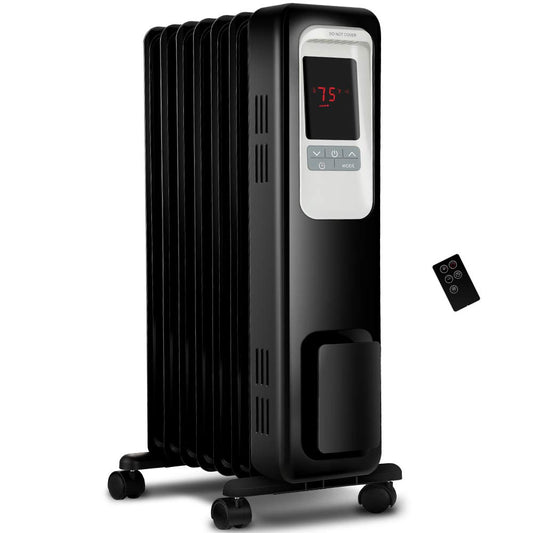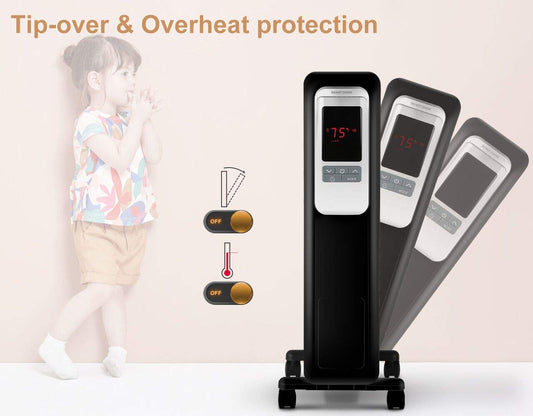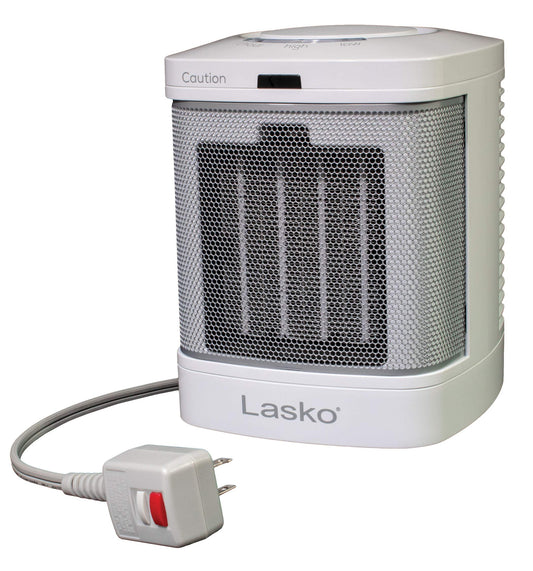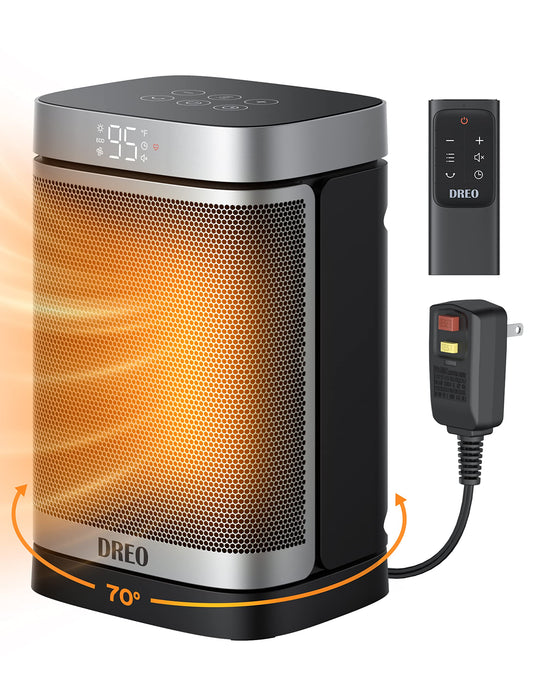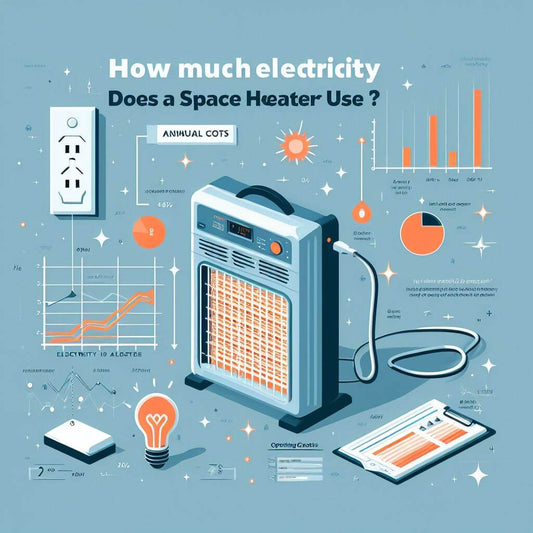How Much Electricity Does a Space Heater Use? Annual Costs Explained
Summary
The amount of electricity a space heater uses depends on its wattage and how often you use it. Learn how to calculate the cost of running a space heater and how to save energy and money in this blog post.

Some links affiliate links that we may earn a commission.
Introduction
Staying warm during frigid winter months is a top priority for many homeowners, especially those living in northern climates where temperatures can regularly drop below freezing. Space heaters provide a supplemental heating source that can be used strategically to warm specific rooms in a home as needed. However, operating space heaters requires a significant amount of electricity to run properly. Gaining a full understanding of the energy consumption, operating costs, and optimal usage of space heaters is key for homeowners who want to incorporate them into their winter heating strategy in a cost-effective manner.
This comprehensive guide will analyze exactly how much electricity a typical space heater unit uses under normal circumstances, examine the costs involved with running a space heater daily over the course of a month or a full winter season, and provide useful tips for using space heaters more efficiently. With this information in hand, homeowners can make fully informed decisions when considering whether to add portable space heaters into their home heating approach for the winter months.
How Many Watts Does a Typical Space Heater Use?
How Much Electricity Does a Space Heater Use? The power consumption of any electrical appliance, including a space heater, is measured in watts. Most standard portable electric space heaters on the market today range from 1,000 to 1,500 watts in terms of their maximum power output. Some larger models designed to heat bigger rooms may go as high as 2,500 watts. The higher the listed wattage of a specific space heater, the more electricity it will consume when operating at full capacity.
To better understand precisely how much raw energy a space heater with a power rating of 1,500 watts uses:
- 1 watt is defined as consuming 1 joule (a unit of energy) per second.
- 1 kilowatt (kW) is equal to 1,000 watts.
- 1 kilowatt-hour (kWh) means 1,000 watts being used for a duration of 1 full hour.
Given those standardized measurements, a space heater rated at 1,500 watts that is running at maximum capacity for 1 hour will use 1.5 kWh of electricity within that hour. This level of energy usage is quite comparable to some other common household electrical appliances and devices:
- Hair dryer: 1,500 - 1,875 watts
- Microwave oven: 1,000 - 1,500 watts
- Window AC unit: 500 - 1,500 watts
While a compact portable space heater may seem small in size, when turned on and running it consumes a similar level of electricity as major kitchen or laundry appliances. This means that a space heater's energy usage can really add up over the course of a day, month, or an entire winter season if used extensively.
Calculating Electricity Usage by a Space Heater Over Time
To gain an accurate understanding of how much it will truly cost to run a space heater on a daily or monthly basis throughout the winter, you will need to calculate the comprehensive electricity usage based on the unit's wattage rating and the number of hours per day and days per month you plan to have it running. Here are the basic formulas to determine full electrical consumption by a space heater over defined periods of time:
- Daily kWh = Heater Wattage x Hours Used Per Day / 1,000
- Monthly kWh = Daily kWh x Number of Days Used Per Month
- Yearly kWh = Daily kWh x Number of Days Used Per Year
Let's look at a sample scenario for a typical homeowner using a standard space heater over the course of a winter season:
- Space heater wattage: 1,500 watts
- Hours used per day: 6 hours
- Days used per month: 30 days
Daily kWh = 1,500 watts x 6 hours / 1,000 = 9 kWh
Monthly kWh = 9 kWh x 30 days = 270 kWh
Yearly kWh = 9 kWh x 365 days = 3,285 kWh
Based on this projected usage pattern, running a 1,500 watt space heater for 6 hours each day can accumulate over 3,000 kWh annually.
To put this in perspective, a recent study by the U.S. Energy Information Administration found the average annual electricity consumption for an entire U.S. household is about 10,000 kWh. So using a standard space heater as the main supplemental heating source for one room every evening could add 30% or more on top of a home's expected total annual electrical usage. Clearly, even an energy-efficient compact space heater running frequently can use up a substantial amount of power over time.
Performing a Cost Analysis of Operating a Space Heater
Without question, the biggest factor in determining the true cost of operating a space heater in your home is the standard electricity rate you are paying your local utility company per kWh of usage. According to the latest data from the U.S. Energy Information Administration, the average residential electricity rate across the entire U.S. is around 13.6 cents per kWh. However, there is significant variation in rates across different states based on regional energy costs and state energy policies. For example:
- Louisiana: 9.35 cents per kWh (lowest contiguous U.S. average rate)
- California: 22.15 cents per kWh (highest U.S. average rate)
To demonstrate how the cost of running a space heater can vary based on location, let's take two examples from states with very different electricity rates:
Louisiana
- Space heater wattage: 1,500 watts
- Daily hours used: 6 hours
- Electricity rate: 9.35 cents/kWh
Daily kWh = 1,500 watts x 6 hours / 1,000 = 9 kWh
Daily cost = 9 kWh x $0.0935/kWh = $0.84
Monthly cost = Daily cost x 30 days = $25.24
California
- Space heater wattage: 1,500 watts
- Daily hours used: 6 hours
- Electricity rate: 22.15 cents/kWh
Daily kWh = 1,500 watts x 6 hours / 1,000 = 9 kWh
Daily cost = 9 kWh x $0.2215/kWh = $1.99
Monthly cost = Daily cost x 30 days = $59.76
Based on this cost comparison, we can see a California homeowner pays 137% more to operate the same space heater using the same amount of electricity because the utility rates are so much higher. Over the course of an entire winter, this cost differential really adds up. Understanding your local electricity rate is key for accurately projecting the cost of operating a space heater.
Tips for Using Space Heaters More Efficiently
Here are some practical tips homeowners can follow to use their space heater in the most efficient manner possible to help reduce energy consumption and cut down on associated electricity costs:
- Lower the thermostat temperature when away from home or sleeping to conserve power.
- Place the space heater near where concentrated heat is needed most, rather than in the center of a room.
- Use insulating curtains, shades or plastic sheets on windows to better retain warmth.
- Maintain a safe distance of at least 3 feet clear around the space heater.
- Purchase ENERGY STAR rated space heater models for improved energy efficiency.
- Use timers or smart plugs to automatically turn unit off when not needed.
- Choose the proper heater size for each room for ideal coverage.
- Supplement with insulation in attics, walls, windows, doors to hold in heat.
Carefully evaluating room size, positioning the heater properly, and utilizing supplemental insulation techniques can allow a space heater to provide effective warmth without excessive energy waste.
Exploring Alternatives to Portable Electric Space Heaters
While portable space heaters can certainly be handy for conveniently adding a heat boost to specific rooms as needed, they are not necessarily the most energy efficient solution for whole-home heating compared to centralized heating systems. Here are some other home heating options homeowners may want to consider:
Electric Central Heating
Many homes today utilize a permanently installed electric central heating system with an electric furnace or electric heat pump. Properly installed central heating can often provide full home warmth more efficiently than portable space heaters, especially if the home has suitable insulation. However, using an electric furnace as the sole heat source can still have high energy costs in some regions compared to alternatives.
Heat Pumps
Heat pumps provide economical heating and cooling by transferring heat between indoor and outdoor air. The most efficient heat pump systems can provide home heating at less than half the cost of electric resistance heating. While more expensive upfront, investing in an ENERGY STAR certified heat pump can yield significant energy savings over time, especially in warmer southern climates.
Natural Gas Central Heating
If available in your region, central heating systems powered by natural gas combustion can provide an affordable alternative to electric space heaters. The cost efficiency depends on the age and condition of the furnace. Upgrading to a newer high-efficiency gas furnace can further reduce heating costs. Just be sure to get an annual furnace tune-up for safety.
Pellet Stoves/Fireplaces
Pellet stoves and fireplace inserts burn small compressed wood pellets to generate focused heat. Newer pellet-burning appliances are very clean and energy efficient. The major limitation is needing bulk deliveries of pellets, plus maintenance like ash removal and chimney cleaning.
Solar Thermal Heating
One renewable energy option is using free heat from the sun. Solar collectors on the roof absorb heat energy that can supplement hot water production and space heating needs. Solar heating is very eco-friendly but involves a substantial upfront investment, so the cost savings potential depends on your climate and utility rates.
Conclusion
After reviewing the typical energy consumption, operating costs, and usage best practices, it is clear that portable electric space heaters, while remarkably convenient, do use a substantial amount of electricity if relied on extensively for daily winter heating. For homeowners seeing skyrocketing electrical bills after using space heaters to stay warm this winter, take steps like lowering the thermostat at night, adding insulation, buying an energy-efficient model or exploring alternatives like a heat pump. Carefully evaluating the realistic costs of operating space heaters allows homeowners to make fully-informed decisions about incorporating them into an efficient and cost-effective whole-home heating strategy.

